The Panasonic Lumix S Pro 70-200mm F2.8 O.I.S is the second 70-200 mm lens in the company’s L-mount full-frame mirrorless Lumix S series. It’s the first to feature a f/2.8 maximum aperture, following the more accessibly priced f/4 model. As such, it’s designed for professional use and features a complex optical design consisting of 22 elements arranged in 17 groups. To suppress chromatic aberration it has three Ultra Low Dispersion UED and three Extra-low Dispersion (ED) elements. It’s also equipped with an aspheric lens to help mitigate astigmatic behavior and improve resolution. The lens has optical image stabilization which, when combined with 5-axis in-body sensor stabilization of the current Lumix S series cameras, provides up to 7 stops of correction.
Autofocus uses a linear motor for fast, quiet focusing and it has second stepping-type motor, giving control over two groups for aberration correction at close range at all focal lengths. It also has a mechanism to mitigate “focus-breathing,” making it well-suited for filming.
Externally, it has three customizable control buttons and a separate focusing collar with a focus clutch that allows fast switching between AF and MF. It also features separate focus limiter and OIS switches, and comes with a removable tripod collar complete with a built in Arca-style compatible foot.
You can view the results for all tested lenses and create your own comparisons and in-depth analyses using our interactive image lens comparison tool.
Key specifications:
- 22 elements in 17 groups
- Three ED elements, three UED and one aspherical
- 11-blade, rounded aperture
- Linear and stepper AF motors
- Stabilization up to 7-stops correction combined with in-body IS
- Dust- and moisture-resistant
- 82 mm filter thread
- Minimum focus distance: 0.95 m ( 3.12 ft)
Test results
We tested the Panasonic Lumix S Pro 70-200mm F2.8 O.I.S on the Panasonic Lumix DC-S1R, currently the highest-resolution camera in the maker’s lineup, with the combination achieving a DXOMARK score of 34. Given that we test the RAW files from the lens with a camera body, it’s worthy noting that the choice of camera affects the results. Different results would be expected with other camera models, especially those with a sensor with a different resolution.
The Panasonic Lumix S Pro 70-200mm F2.8 O.I.S has good sharpness at almost every aperture and focal length, the exception being f/22, where sharpness decreases significantly due to diffraction. It has good center sharpness and it’s a strong performer at the longer end when stopped down a little. The lens is also well corrected for geometric distortion, which is always lower than 0.5%, and it has low levels at longer focal lengths.
Slight vignetting or corner shading is visible at the maximum aperture and particularly at either end of the zoom range. In general, though, it is very well controlled throughout. The Panasonic lens also has excellent transmission, measured at T2.9 at 70 mm, however, it’s not as consistent as rivals throughout the focal range. The transmission drops to T3.1 above 70 mm, though it is quite consistent at that stage in the zoom range. If there’s one slight drawback, it’s in suppression of lateral chromatic aberration, as it has rather high levels towards the longer focal lengths, and especially at 200 mm.
Overall, though, the Panasonic Lumix S Pro 70-200mm F2.8 O.I.S is a good performer generally.
In-depth comparisons
We’ve compared the Panasonic Lumix S Pro 70-200mm F2.8 O.I.S on the Lumix DC-S1R against the Sony FE 70-200mm F2.8 GM OSS model from Sony on the Sony A7R II. The Sony A7R II is the closest to the Lumix DC-S1R in pixel count and likely in resolution (resolving power) in our database. This should better facilitate direct comparisons when assessing sharpness between the two systems. At around $2,600, the 2016 Sony lens is the same price as the Panasonic Lumix S Pro 70-200mm F2.8 O.I.S.
We’ve also compared the Panasonic Lumix S Pro 70-200mm F2.8 O.I.S with the Nikkor Z 70-200mm F2.8 VR S on the Nikon Z7, a high-end model like the Lumix DC-S1R with a similar-resolution sensor. The Nikkor Z 70-200mm F2.8 S version cost around $2699 at launch.
You can see an overview of this comparison in our database.
Sharpness
The Panasonic Lumix S Pro 70-200mm F2.8 O.I.S has impressive sharpness in the center of the frame at all apertures and focal lengths. However, while it has very good sharpness centrally at f/2.8 at 70 mm, corner sharpness is well behind. Stopping down one stop to f/4 improves sharpness only slightly and it takes stopping down three stops to f/8 for the corners to come up to the center. This weaker performance in the outer zones and corners is restricted to the shorter end. At 105 mm and longer focal lengths up to 200 mm, closing down just one stop sees much better, more consistent sharpness across the image field.
The Nikkor Z 70-200mm F2.8 S has slightly higher sharpness wide-open in the centers at all focal lengths and it has much better corner sharpness at shorter focal lengths, particularly at 70 and 85 mm all the way through to f/11. As you zoom through the range, though, corner sharpness in the Panasonic Lumix S Pro 70-200mm F2.8 O.I.S gradually catches up by 200 mm.
Against the Sony FE 70-200mm F2.8 GM OSS, the Panasonic Lumix S Pro 70-200mm F2.8 O.I.S has similar sharpness levels wide-open, but the Sony has the better center and corner sharpness at 200 mm. Stopped down, from f/4 onwards, the two have very similar sharpness profiles, but the Sony has higher levels at each aperture, and taken as a whole, it’s the sharpest of the three overall.
Chromatic aberration
Despite the adoption of six ED glass elements, including three ultra-low dispersion types, the Panasonic Lumix S Pro 70-200mm F2.8 O.I.S still has slightly higher than expected levels of lateral chromatic aberration (LCA). Although this is relatively easy to remove in software, fringing can reduce sharpness levels, and that is difficult to remedy in post-processing. At shorter focal lengths and all the way through to 135 mm, the Panasonic Lumix S Pro 70-200mm F2.8 O.I.S has low levels and mitigates the effects very well, but it has very high levels at 200 mm — exceeding 15 microns at every aperture. Both rivals in this comparison mange to keep levels in check, though at 200 mm they also show higher levels than at other focal lengths.
Geometric distortion
Control of geometric distortion correction is best achieved optically rather than in-camera or later in software, and the Panasonic Lumix S Pro 70-200mm F2.8 O.I.S performs well in this regard. It has low levels of barrel distortion, measured at just 0.4 at 70 mm and increasing to a still very low 0.3% pincushion at 200 mm. It’s the best of the three overall when averaged, though the Nikkor Z 70-200mm F2.8 S has the lowest barrel distortion, measured at just 0.1% at 70 mm and rising to 0.6% pincushion at 200 mm.
Vignetting (corner shading)
One of the highlights of the Panasonic Lumix S Pro 70-200mm F2.8 O.I.S is its relatively low vignetting. Like most 70-200 mm f/2.8 zooms, the Panasonic has less vignetting at the shorter end, with shading becoming increasingly more noticeable throughout the zoom range. In measurement terms, its highest level is just -1 EV in the corners, and that value is actually pretty consistent throughout the zoom range. However, visually the effect has more weight at 200 mm, where there’s a smaller central core that’s free of shading. Both the Nikkor Z 70-200mm F2.8 S and the Sony FE 70-200mm F2.8 GM OSS peak at around -1.4 EV in the corners at 70 mm, increasing to around -2 EV at 200 mm.
Transmission
High transmission is a sought-after characteristic and particularly so when it’s consistent in zoom lenses, otherwise it can lead to a distracting change in exposure levels during zooming. While the Panasonic Lumix S Pro 70-200mm F2.8 O.I.S lens is consistent from 85 mm through 200 mm, there’s a +0.2 EV difference at 70 mm, which may be troubling to resolve during filming. In terms of consistency, it’s a little worse than the Nikkor Z 70-200mm F2.8 S — and both the Nikkor and the Panasonic are well behind the leader in the group, the more consistent and “faster” Sony FE 70-200mm F2.8 GM OSS at T2.9.
Conclusion
Many professionals rely on a 70-200 mm f/2.8 on a daily basis and it has become an important benchmark in any manufacturer’s lineup. For Panasonic, only recently entering the full-frame market, the performance of this lens is crucial if it’s to entice users away from the “big three” — Canon, Nikon, and Sony. In many respects this lens is a very good performer, with good central sharpness at all focal lengths and both low distortion and vignetting, but it can’t quite match the consistent sharpness of the Nikkor wide-open at all focal lengths, and it lacks the higher sharpness of the Sony once it’s stopped down. It’s good, even very good, but not quite at the same level as its rivals.
In this review, we have compared the Panasonic Lumix S Pro 70-200mm F2.8 O.I.S. mounted on a Panasonic Lumix DC-S1R to its closest rivals from other brands. Remember that the lenses may be used on various cameras with different sensors, or in some cases on different camera systems using different mounts, so the results will vary between them.
As usual, you can create your own comparisons and in-depth analyses using our interactive image lens comparison tool.


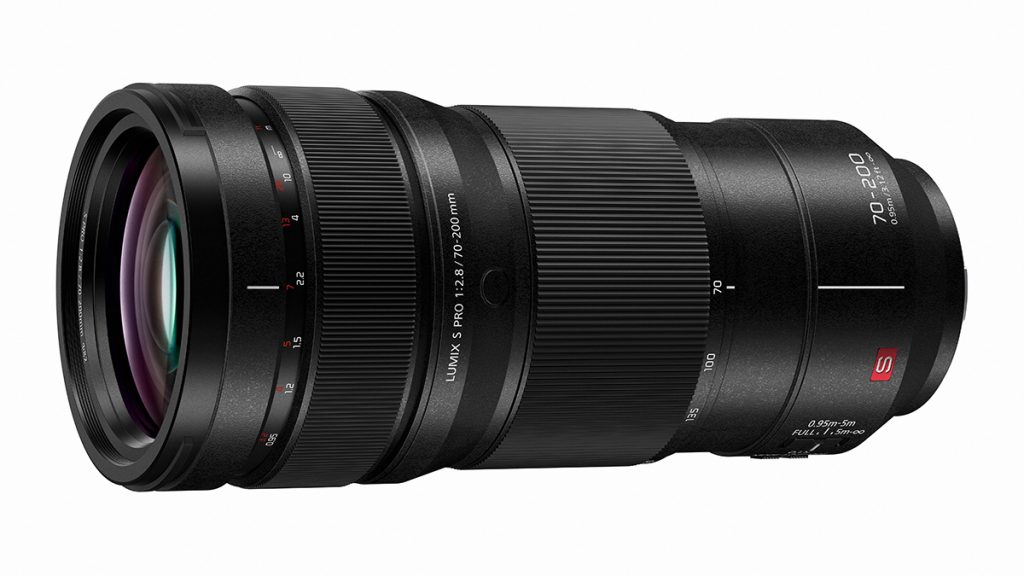


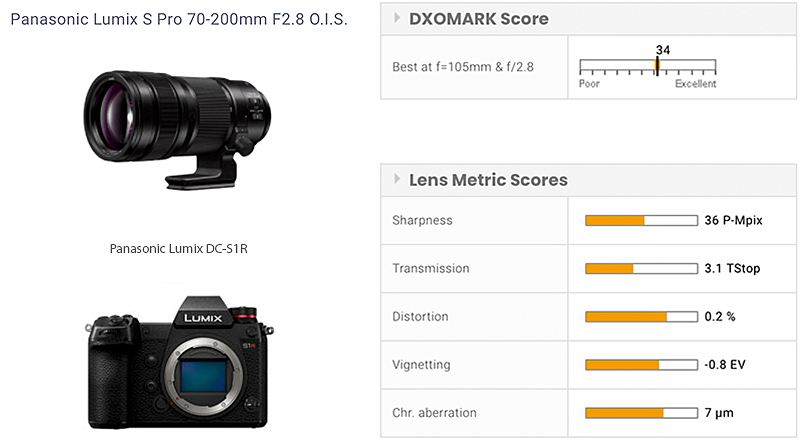
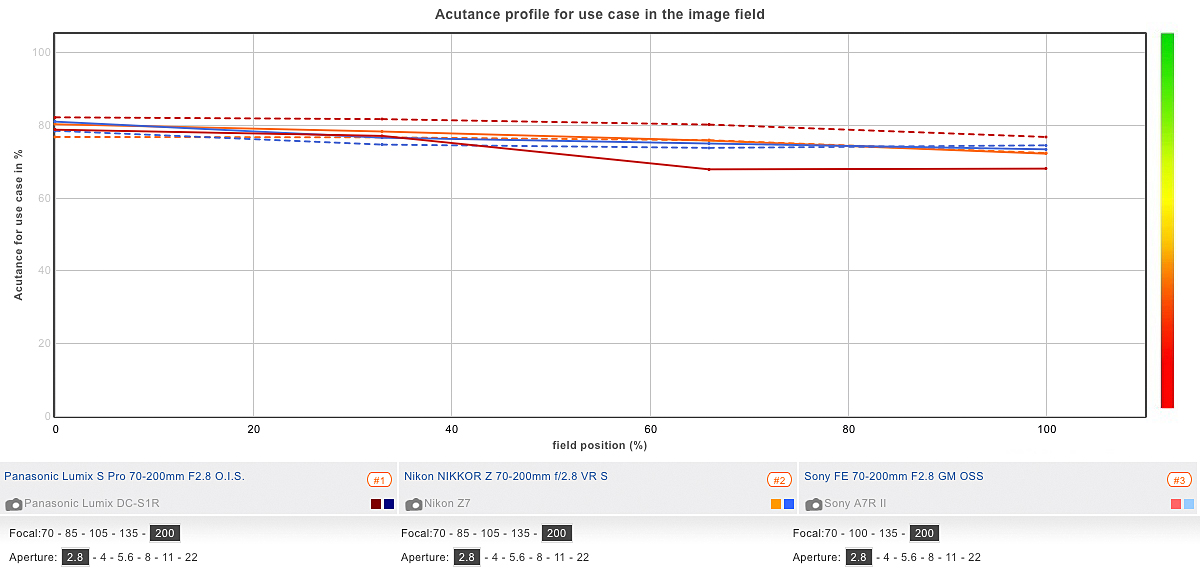
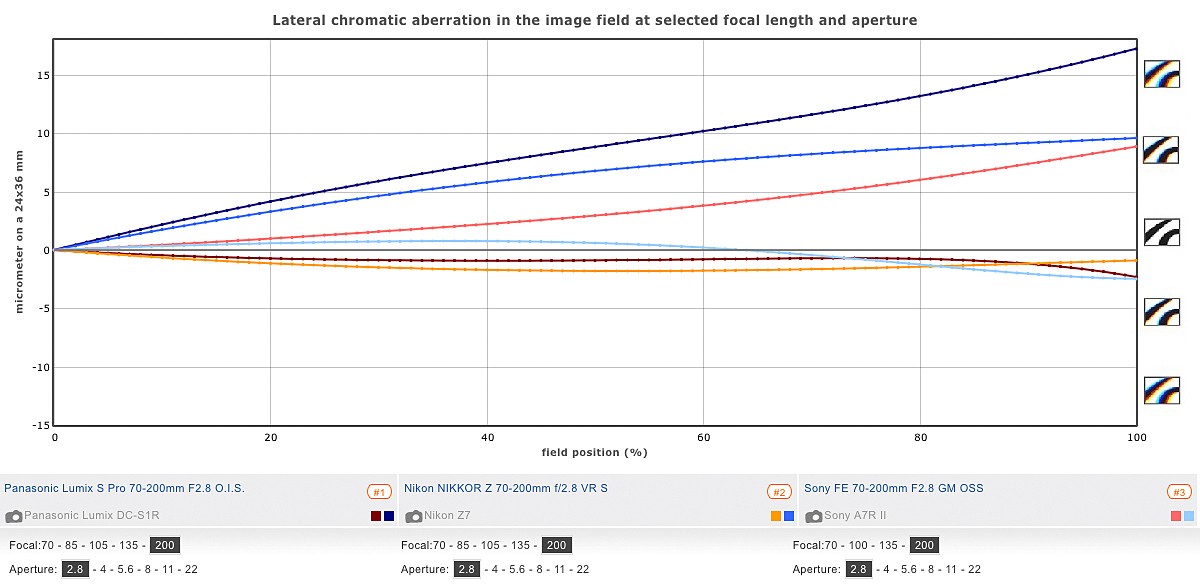
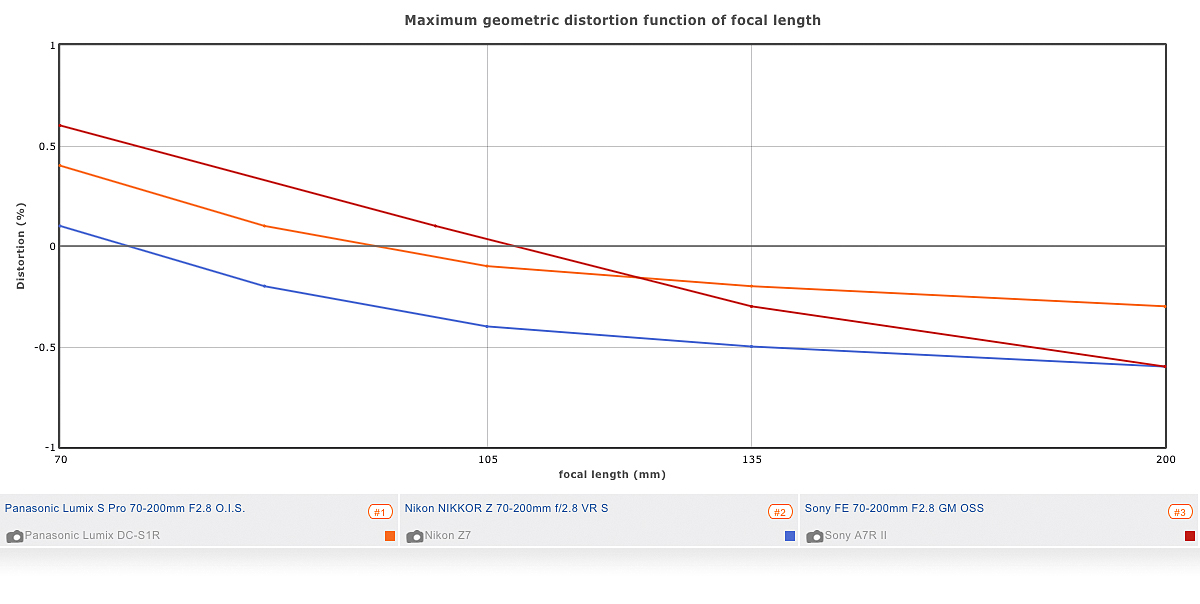
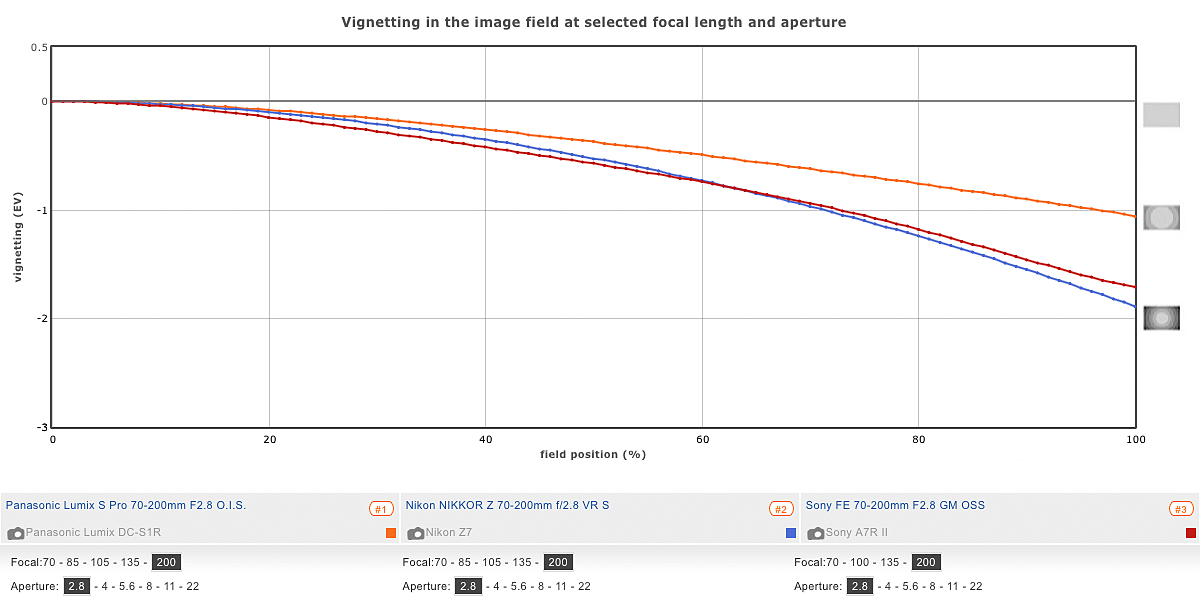
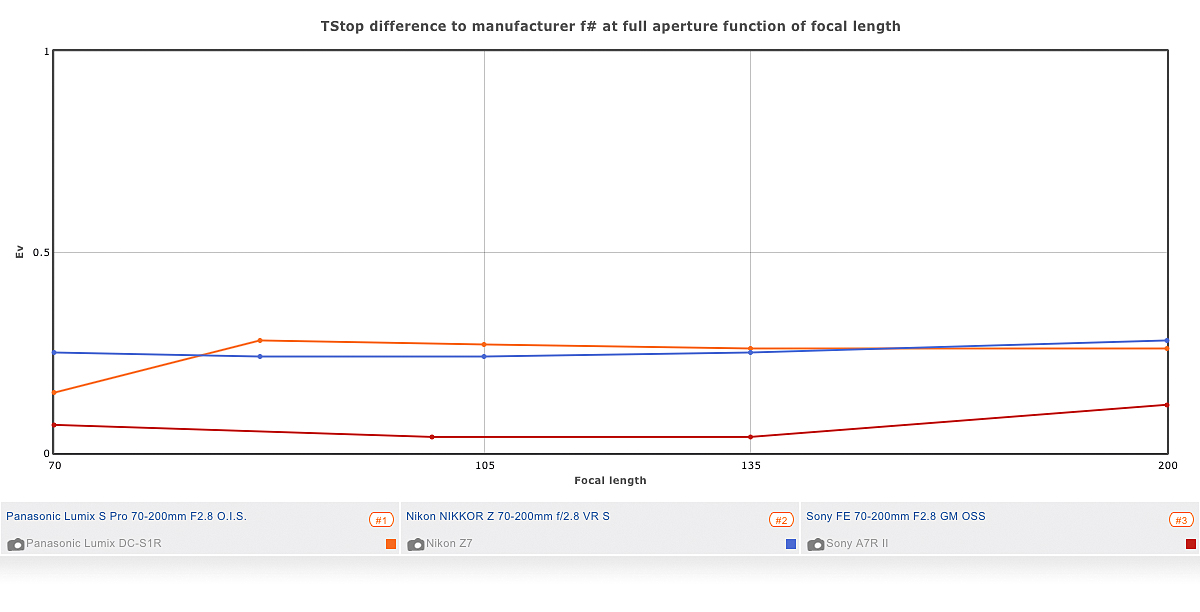
DXOMARK encourages its readers to share comments on the articles. To read or post comments, Disqus cookies are required. Change your Cookies Preferences and read more about our Comment Policy.